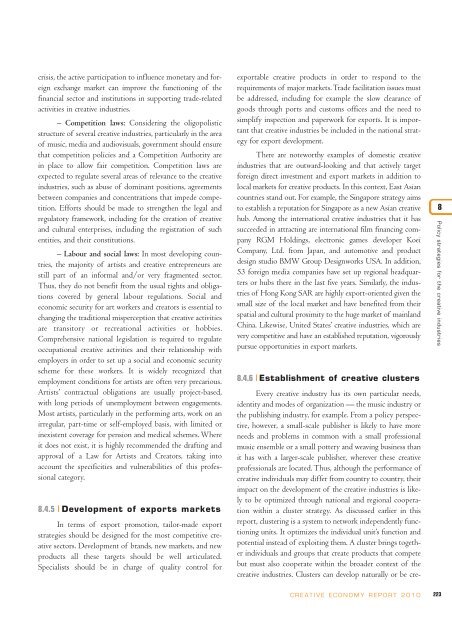Creative Economy: A Feasible Development Option
Creative Economy: A Feasible Development Option
Creative Economy: A Feasible Development Option
- No tags were found...
You also want an ePaper? Increase the reach of your titles
YUMPU automatically turns print PDFs into web optimized ePapers that Google loves.
crisis, the active participation to influence monetary and foreignexchange market can improve the functioning of thefinancial sector and institutions in supporting trade-relatedactivities in creative industries.– Competition laws: Considering the oligopolisticstructure of several creative industries, particularly in the areaof music, media and audiovisuals, government should ensurethat competition policies and a Competition Authority arein place to allow fair competition. Competition laws areexpected to regulate several areas of relevance to the creativeindustries, such as abuse of dominant positions, agreementsbetween companies and concentrations that impede competition.Efforts should be made to strengthen the legal andregulatory framework, including for the creation of creativeand cultural enterprises, including the registration of suchentities, and their constitutions.– Labour and social laws: In most developing countries,the majority of artists and creative entrepreneurs arestill part of an informal and/or very fragmented sector.Thus, they do not benefit from the usual rights and obligationscovered by general labour regulations. Social andeconomic security for art workers and creators is essential tochanging the traditional misperception that creative activitiesare transitory or recreational activities or hobbies.Comprehensive national legislation is required to regulateoccupational creative activities and their relationship withemployers in order to set up a social and economic securityscheme for these workers. It is widely recognized thatemployment conditions for artists are often very precarious.Artists’ contractual obligations are usually project-based,with long periods of unemployment between engagements.Most artists, particularly in the performing arts, work on anirregular, part-time or self-employed basis, with limited orinexistent coverage for pension and medical schemes. Whereit does not exist, it is highly recommended the drafting andapproval of a Law for Artists and Creators, taking intoaccount the specificities and vulnerabilities of this professionalcategory.8.4.5 <strong>Development</strong> of exports marketsIn terms of export promotion, tailor-made exportstrategies should be designed for the most competitive creativesectors. <strong>Development</strong> of brands, new markets, and newproducts all these targets should be well articulated.Specialists should be in charge of quality control forexportable creative products in order to respond to therequirements of major markets. Trade facilitation issues mustbe addressed, including for example the slow clearance ofgoods through ports and customs offices and the need tosimplify inspection and paperwork for exports. It is importantthat creative industries be included in the national strategyfor export development.There are noteworthy examples of domestic creativeindustries that are outward-looking and that actively targetforeign direct investment and export markets in addition tolocal markets for creative products. In this context, East Asiancountries stand out. For example, the Singapore strategy aimsto establish a reputation for Singapore as a new Asian creativehub. Among the international creative industries that it hassucceeded in attracting are international film financing companyRGM Holdings, electronic games developer KoeiCompany, Ltd. from Japan, and automotive and productdesign studio BMW Group Designworks USA. In addition,53 foreign media companies have set up regional headquartersor hubs there in the last five years. Similarly, the industriesof Hong Kong SAR are highly export-oriented given thesmall size of the local market and have benefited from theirspatial and cultural proximity to the huge market of mainlandChina. Likewise, United States’ creative industries, which arevery competitive and have an established reputation, vigorouslypursue opportunities in export markets.8.4.6 Establishment of creative clustersEvery creative industry has its own particular needs,identity and modes of organization — the music industry orthe publishing industry, for example. From a policy perspective,however, a small-scale publisher is likely to have moreneeds and problems in common with a small professionalmusic ensemble or a small pottery and weaving business thanit has with a larger-scale publisher, wherever these creativeprofessionals are located. Thus, although the performance ofcreative individuals may differ from country to country, theirimpact on the development of the creative industries is likelyto be optimized through national and regional cooperationwithin a cluster strategy. As discussed earlier in thisreport, clustering is a system to network independently functioningunits. It optimizes the individual unit’s function andpotential instead of exploiting them. A cluster brings togetherindividuals and groups that create products that competebut must also cooperate within the broader context of thecreative industries. Clusters can develop naturally or be cre-8Policy strategies for the creative industriesCREATIVE ECONOMY REPORT 2010223
















